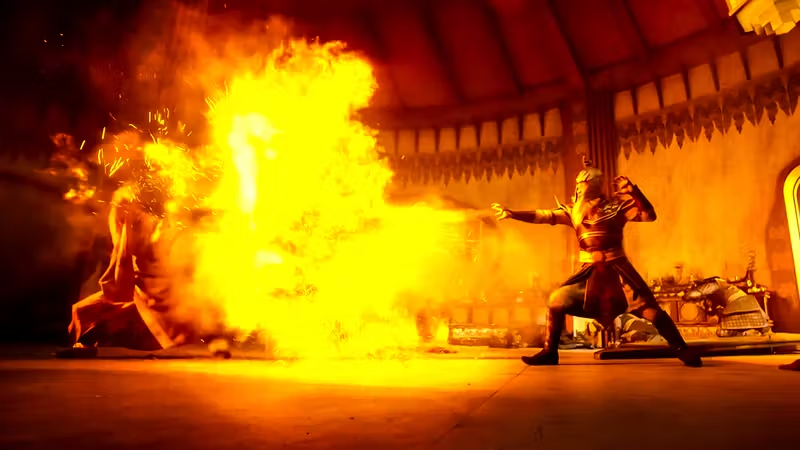Sorry, nothing in cart.
Avatar Netflix DP Michael Balfry Reveals Why Firebenders Were So Hard to Bring to Lifes
Avatar Netflix DP Michael Balfry Reveals Why Firebenders Were So Hard to Bring to Life
Michael Balfry, the director of photography for Netflix’s Avatar: The Last Airbender, revealed that firebenders were the most difficult type of bender for the show to bring to life.
While many might have problems with the new adaption, most agree that the elemental bending demonstrated in the series is generally well done. It’s certainly better than the 2010 live-action film which needed six earthbenders to move one small pebble.
How Firebenders Were Difficult To Pull off in Avatar Netflix Show
In an exclusive interview with The Direct’s Russ Milheim, Avatar: The Last Airbender director of photography (DP) Michael Balfry revealed why firebending was the most difficult form of bending to bring to life convincingly.
The DP shared that the key challenge in filming the firebenders was “trying to make [firebending look] natural:”
“I would say firebending. Trying to make it [look] natural… When we’re filming a fireplace or a campfire… we don’t always use real fire for practicality [reasons]. If you’re inside, you can’t have a flame bar. So you use lighting [while] trying to make sure [it looks real]. And people will see where it’s fake and not fake. So trying to keep it subtle is always the challenge.”
On set, the filmmaker also explained how they’d “[have] lights in their hands” to “add just a little practical light to glow up their face:”
“The firebending would be mostly the lighting. When their hands are glowing, we would add just a little practical light just to glow up their face, again, to sell that credibility to give effects something to work with. We had lights in their hands that would glow, and then they would just build the flames out of that.”
“The best way to approach VFX is always trying to keep it simple,” Balfry explained, revealing an age-old filmmaking technique used to film water whips:
“The best way to approach VFX is always to try to keep it simple. And that’s always the hardest thing sometimes. With the water, that was straightforward filming; although we’d be on a character, and they would throw a whip of water, we’d whip off the character. And then another shot would take whipping into wherever it was landing.”
The Fire Nation surprised many fans as they watched the new live-action series, which got notably darker than the original animated show. After all, people were consistently being burned alive.
When asked if they ever had to tone anything down, Balfry noted that “[nothing] was brought up to [his] attention,” but the idea was to capitalize on the Fire Nation’s “inhumane approach just to kill, kill, kill:”
“Not consciously? No, nothing that was brought to my attention. I mean, we did realize that our audience would be younger, as well as people in their 30s and 40s who’d watched it. You keep that in mind. But we were not into the big blood and gore… There are the big fire explosions and the implications of people burning… The idea is to keep [the firebender’s] ferociousness their inhumane approach just to kill, kill, kill.”
The brutality of the firebenders can be seen at its peak in the opening minutes of Episode 1, where viewers witness the genocide of the air nomads—which was not in the animated show.
It was “a lot of work,” noted Balfry, with the sequence only being possible thanks to the stunt team:
“It’s a lot of work. It was very exciting… And when I say it was a lot of work, the stunt team [did a lot ]. I mean… when I saw it put together, and the visuals were put in because it was shot on a green screen, obviously. We had some set pieces, the stairs, and stuff on rocks and whatnot, on set. But it was the stunt team that really made this happen.”
He continued praising the stunt team, calling out their tireless work and constant rehearsing:
“They work tirelessly, for days, probably weeks ahead of time, behind the scenes rehearsing, and we’d go in through the rehearsals and watch what they’re doing, the director myself, or they’d film it. Then, they’d put a bit of a mini montage of what they envisioned. And things would get tweaked from there.”
Another sequence with the firebenders at the core of the action was when the moon died in the Season 1 finale, and all color drained out of the world.
Turns out, getting that to display correctly on-screen was a relatively simple process on Balfry’s part, primarily thanks to the use of LED lighting on set:
“A combination of practical lighting on set–we’re shooting all LED, and that was on The Volume and also on the bridge at the end. So, with LED, changing colors is much easier to do. I started the process on set. Basically, when the moon goes red, then all the LEDs went red. And when the moon’s gone, [post production] did a lot of work in that by stripping the color.”
Eagle-eyed viewers may notice that the only color popping up from that point on belonged to the light coming from the firebender’s flames:
“My motivation is always keeping the practicals, the flames, and whatnot true and then letting everything else go to where it’s supposed to go… Psychologically, you’re thinking, ‘Okay, that flame looks normal, so the rest of the world is not, and then it helps sell that concept.’”
Avatar: The Last Airbender is now streaming on Netflix.





Leave a Reply